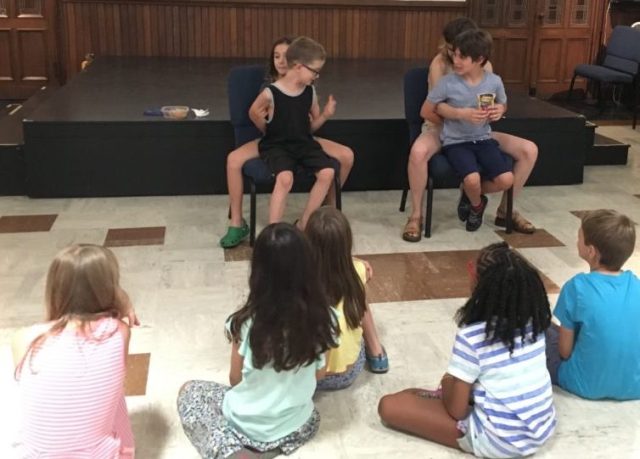Indoor play can be as purposeful as it is silly. While the best games are obviously screen-free, they are also mess-free—who needs more stuff to clean up? Ideally, there is a clear structure that parents set up that kids can then ultimately master and take over.
The game, “Hands Through,” not only checks all those boxes, it is incredibly joyful to play.
Watch an expert weigh-in from Small Brooklyn Psychology to learn how (and why) to play “Hands Through” —the only indoor play game you’ll ever need.
Here’s How to Set-up the Game:
1. Player One sits in a chair, with their arms out in front of them. They are the “Hands”.
2. Player Two sits in front of Player One and clasps their own hands behind their back. They are the “Talker”.
3. “Hands” threads their arms through the space between “Talker’s” ribs and arms.
4. Then, “Hands” hides their head under a cloth, coat or oversized sweater.
The Crux of the Game:
Once the players are in position, the game starts. Encourage the “Hands” to really gesture. It is essential that they are really active and creative, finding lots of ways to connect with the object, gesture, and engage with the “Talker.”
I find it helpful if there is a third person as an interviewer. Depending on the age of your players, this interviewer can be an adult or a kid who is able to keep the momentum of the game going by asking great leading questions.
Once you model the style of an interview, kids (ages 5 and up) are more than able to step into this role as well. Here are some ways to scaffold “Hands Through” so that it has a little narrative flow. In these variations, the “Talker” can be…
- An expert in something and the interviewer asks them all about it.
- Selling something, infomercial-style.
- Speaking in character based on a person from a book they love.
Tips on Play:
As part of scaffolding the play, set a clear signal for the players to either switch or trade out with other kids. For example, asking how much their object costs, asking the viewers —if there is an audience—if they would like to buys said object, or simply setting a timer and having it go off to signal the end of the turn.
Above all, make sure that you are silly and go with your instincts as an adult player. Watch this for more ideas on how to use improv to enhance playing with your kids during indoor play.
Tools you Need
- Chair
- Cloth to hide the person in back—this can be a big scarf, sweater or coat
- Any kind of prop for the “Hands” to hold onto to.
- pretend microphone to direct the speaker (I use an iPhone or a pen!)
Why is this game so worthwhile? Not only is it collaborative, but this game also makes your kid a better listener. The players have to be incredibly connected and listening to each other, although not in the traditional sense. The person playing the “Hands” is communicating, but not through words. Rather, their gestures and actions have to be “listened” to and processed by the “Talker” in front. They are a complicit team: essentially, two people become one.
Accurately reading non-verbal communication is an important skill for any child to learn. Gestures and body movements are as much a language as words. This game offers the practice of interpreting these kinds of gestures, all through play. The joy of this game also comes from working hard to synch up the gestures the “Hands” make in the back with the story of the “Talker” in the front. The “Talker” has to justify the moves that the “Hands” come up with. The only way this successfully works is if there is true attention—listening—paid to the body language.
Here are some examples I have seen in Child’s Play NY classes, where kids work together, listening to gesture.
The Hands…
- start tapping the side of head the Talker in front, and the “Talker” starts to discuss how smart or how much she knows.
- aggressively point to onlookers and the “Talker” decides to reprimand someone.
- use their fingers to count, and the “Talker” has to say the number the Hands come up with.
- begin to comb hair, pat face, squeeze cheeks and the “Talker” has to discuss and justify each of these actions.
Impulse Control: Although the person in the back guides a lot of the playing through their gesture, they are essentially hidden from the audience (except for their hands) and must remain silent. Additionally, the person in front may want to gesticulate as well, but they have to restrain themselves as their hands are behind their back and the illusion is destroyed if their hands emerge. Through this game, kids get to practice impulse control by way of play.
Perspective Taking: Another social-emotional benefit of this game is that kids get to practice perspective-taking. As the two players literally merge into one, they have to take on the other player’s perspective in order to create a unified person and story.











